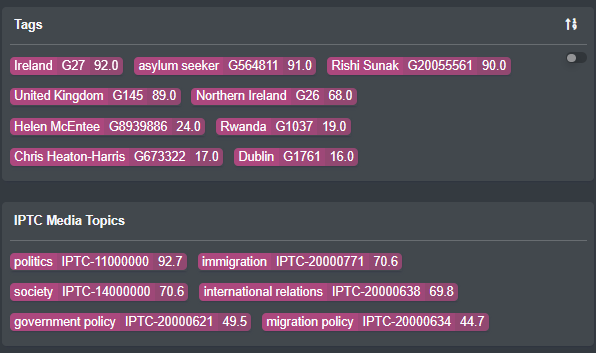In today’s newsrooms, assigning metadata to articles has become an essential part of the publishing process. Metadata includes information such as the author’s name, the publication date, and the section of the website the article belongs to (e.g., culture or sports). The purpose of this metadata is to provide quick, structured information about an article that can be used to analyze your published content.
In this post, we’ll focus on a specific type of metadata known as semantic tags—also called content tags, keywords, or simply tags. These go beyond basic metadata and allow for much more detailed classification of articles. But before we dive into how semantic tags can support newsroom workflows, let’s first explain what they are and how they’re created.
What Are Semantic Tags and What Are They For?
Semantic tags are words or phrases that capture the core content of a text. For example, an article about parliamentary elections might include tags like the names of key politicians, political parties, or the key phrase “parliamentary elections.”
Tags are a vital part of working with text because they help transform unstructured data into structured data. This makes articles easier to process with machines—for example, for analysis, search, personalization algorithms, data analytics, ad matching, and more.
How Are Semantic Tags Created?
In many newsrooms, tags are still added manually. But manual tagging is time-consuming and comes with other downsides, such as inconsistency and duplication. For example, “Wolfgang Amadeus Mozart,” “composer W. A. Mozart,” and simply “Mozart” could all refer to the same person, yet be treated as separate tags.
To improve tag quality and free up editorial resources, consider using automatic tagging. This can either suggest tags for human approval or assign them automatically. The advantages include high speed (real-time processing), accuracy, consistency across articles, and no duplication. We’ve explored in more detail how tagging works and why automatic tagging is preferable to manual tagging in this article.
Geneea’s Tagger selects tags from two main sources: the most important entities identified in the text (such as people, places, or organizations), and the categories or topics assigned to the article.
Let’s take a news article about a NATO military exercise. The top-ranked entities would likely include “NATO” and, for example, “Mark Rutte.” The article would also be tagged with categories like “national security” and “armed forces.” But what about Instagram, where Mark Rutte reportedly shared his statement? Even though Instagram is recognized as an entity, it’s considered less important in the context of the article, so it doesn’t earn enough relevance points to become a tag.
Sources of Tags
Tags can come from several types of data, each contributing to a richer and more accurate understanding of the article’s content:
Entities
- Named Entities: These are specific names of people, locations, organizations, or products that appear directly or indirectly in the text—for example, Bill Gates, France, Instagram, or Game of Thrones.
- General Entities: These are broader terms or phrases that describe concepts or topics, such as global warming, income tax, or smartphone. We often refer to them as keywords.
- Events: These include events like festivals, holidays, hurricanes, or major developments such as the war in Ukraine.
Categories
- IPTC Media Topics: A hierarchical taxonomy with over 1,200 categories. For instance, an article about the election of a new president would likely be tagged with categories like politics and government and elections.
- IAB Content Taxonomy: A classification system used primarily for marketing purposes to categorize article content.
- IAB Brand Safety Categories: A specialized subset of the IAB Content Taxonomy focused on detecting explicit, harmful, or otherwise brand-unsafe content that advertisers may want to avoid.
Editorial Tags (Custom): If a newsroom assigns its own custom tags to a set of articles, our system can learn these patterns and automatically apply the appropriate tags to future content. For example, if you regularly tag articles with For Parents to target content relevant to families, the system will recognize this usage and apply it consistently to similar articles moving forward.

What Are the Benefits of Using Semantic Tags in Media?
Some tags are best suited for internal analytics, others help improve business strategies, and some are key for automation.
Let’s take a closer look at the kinds of insights media organizations can gain from well-tagged content—and how they can put that information to use.
For Analytics Departments
Semantic tags offer analysts a clear, structured overview of what your content covers and how it performs.
With Geneea’s entity linking to external sources like Wikidata, Wikipedia, and social media, tags gain even more analytical depth. This enables your editorial team to fine-tune content strategy, tailor topics more precisely to your audiences, and adjust tone and style to better connect with readers. Thanks to our standardized tag IDs, it’s also easy to compare tags across different languages.
Performance Analysis
Recommended tags: IPTC Media Topics, entities
Track how different content categories perform and understand what truly resonates with your audience.
For example, want to know which topics attract attention on your site—and which ones fall flat? Combine tag data with performance metrics like pageviews, time on page, scroll depth, or completion rates (via Google Analytics, Piano Analytics, or your own tools). From experience, we know that even widely popular topics may underperform on some websites, simply because readers are used to finding that information elsewhere.
Content Analysis
Recommended tags: IPTC Media Topics, entities, editorial tags
Are you covering all locations, events, themes, and people evenly—or are some topics overrepresented while others get ignored? Are your expert sources predominantly men? Do you mention a particular political party more often than its actual relevance warrants?
Take a look at how we analyzed the content output of France’s public radio service.
For Readers
Semantic tagging creates a more organized, intuitive news experience for your audience.
Better Content Navigation
Recommended tags: IPTC Media Topics, entities, editorial tags
Publishers can build dedicated sections based on tags—like local news, environmental coverage, or specific sports—so readers can easily access content tailored to their interests.
Discovering Related Content
Recommended tags: entities, editorial tags
Tags and tag-based links within article text make it easier for readers to explore related topics that interest them.
Personalized News Updates
Recommended tags: IPTC Media Topics, entities, editorial tags
Readers can subscribe to the topics they care about—making news delivery more personal and relevant. Whether it’s Paul McCartney, climate change, or for parents, they can receive alerts or notifications whenever new content is published—keeping them informed and engaged.
Improved Search
Recommended tags: IPTC Media Topics, entities, editorial tags
Tags act as smart filters that significantly improve the search experience. Whether you provide full-text search or a combination of full-text and semantic search, tags help narrow down results quickly and accurately. This leads to faster discovery and more relevant results, making it easier for readers to find exactly what they need.
For Publishers
Semantic tagging brings clear, measurable benefits to publishers—from better SEO to more effective personalization and smarter content reuse.
Tags and SEO
Recommended tags: entities, editorial tags
Tags support SEO by interlinking articles, helping search engines understand your website’s structure and hierarchy. They can also pass “link juice” to older articles, increasing their visibility.
By clearly defining an article’s topic, tags help search engines assess the article’s content and purpose more precisely.
Input for Personalization Algorithms
Recommended tags: all types (IPTC Media Topics, IAB Content Taxonomy and Brand Safety, entities, editorial tags)
Tags are useful for content-based recommendation systems, either on their own or to enhance the quality of off-the-shelf embeddings. Hybrid personalization systems—which combine content-based filtering with collaborative filtering—help balance popular content with personal preferences. They also reduce the risk of filter bubbles by promoting content diversity and introducing novel topics.
Improving Content Reuse
Recommended tags: entities, editorial tags
By using tags and tag-based links in article text, publishers encourage readers to engage with older, relevant content—boosting both discoverability and content value.
Content Aggregation
Recommended tags: IPTC Media Topics, entities, editorial tags
Tags can also serve as metadata for aggregating articles across multiple internal sources. This lets you offer specific reader segments personalized content based on their interests.
For Advertisers
Tags give advertisers the precision they need to deliver relevant messages and avoid placements that could harm brand perception.
Contextual Ad Targeting
Recommended tags: IAB Content Taxonomy, entities
If behavioral targeting isn’t an option, contextual advertising is your best alternative. Use tags to connect specific campaigns with matching content categories, ensuring ads appear only next to relevant content—something your advertisers will appreciate.
Brand Safety
Recommended tags: IAB Brand Safety
Help advertisers avoid sensitive or potentially harmful content, such as articles about natural disasters, terrorism, or substance abuse. For example, placing a last-minute vacation ad next to a story about a plane crash could negatively impact brand perception.
With IAB Brand Safety categories, you can guarantee your clients their ads will never appear next to sensitive or inappropriate content—instead, they’ll appear in context that reflects their values and interests.
For Journalists
Semantic tags make it easier to search archives, track topics, and build on previous reporting—supporting faster research and stronger story development.
Advanced Archive Search
Recommended tags: IPTC Media Topics, entities, editorial tags
Tags enhance search capabilities—whether the search system is full-text, semantic, or hybrid. Tags help focus searches on specific areas of your archive, speeding up retrieval, lowering costs, and improving accuracy.
Monitoring
Recommended tags: IPTC Media Topics, entities, editorial tags
Most of the use cases above focus on tagging your own content. However, it’s also possible to monitor external sources, such as the news agencies you subscribe to. This allows you to track relevant topics across those sources with the same structure and consistency applied to your internal publishing. When content matching your selected tags appears, you’ll be notified immediately—helping your newsroom respond quickly and stay ahead of the curve.
Have Another Idea for How to Use Tags in Media?
Let us know! We’d love to discuss it with you and show how our flexible, continuously evolving technical solution can help. Your first consultation is always free. You can also try our tagging system on your own content via the Geneea demo.

